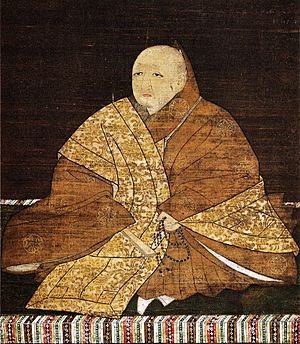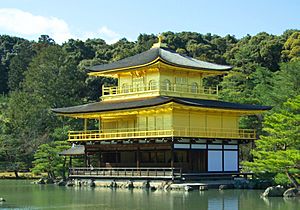Ashikaga Yoshimitsu facts for kids
Quick facts for kids
Ashikaga Yoshimitsu
足利 義満 |
|
|---|---|
 |
|
| Shōgun | |
| In office 1368–1394 |
|
| Monarch |
|
| Preceded by | Ashikaga Yoshiakira |
| Succeeded by | Ashikaga Yoshimochi |
| Personal details | |
| Born | September 25, 1358 |
| Died | May 31, 1408 (aged 49) |
| Spouses |
Among others... |
| Children |
|
| Parents |
|
| Signature |  |
Ashikaga Yoshimitsu (足利 義満, September 25, 1358 – May 31, 1408) was a very important leader in Japan during the Muromachi period. He was the third shōgun (a military ruler) of the Ashikaga shogunate, leading the country from 1368 to 1394.
Yoshimitsu became shogun when he was only ten years old. He was the oldest son of Ashikaga Yoshiakira, the previous shogun. When he was twenty, he joined the imperial court, which was the emperor's government.
One of his biggest achievements was ending a long period of conflict called the Nanboku-chō period. During this time, Japan had two separate imperial courts, which caused a lot of political problems. In 1392, Yoshimitsu successfully brought them back together.
He also improved Japan's relationships with other countries, especially Ming China and Joseon (Korea). He set up trade agreements that lasted for over a hundred years. The Chinese emperor even called him "King of Japan" because of his diplomatic efforts.
After retiring from his public roles in 1395, Yoshimitsu moved to his beautiful villa called Kitayama-dono. This villa included a famous building covered in gold leaf, which is now known as the Golden Pavilion (Kinkaku) at Kinkaku-ji temple. He passed away suddenly in 1408 at the age of 49.
Contents
Yoshimitsu's Life and Rule
Yoshimitsu became shogun in 1368. At the same time, Emperor Chōkei became the leader of the Southern Court.
Bringing Peace to Japan
For over 50 years, Japan had two rival imperial courts: the Northern Court and the Southern Court. This period was known as the Nanboku-chō period. It caused a lot of fighting and instability.
Yoshimitsu worked hard to end this conflict. In 1392, he convinced Emperor Go-Kameyama of the Southern Court to give the Imperial Regalia (special treasures that show who the true emperor is) to Emperor Go-Komatsu of the Northern Court. This act finally reunited the two courts and brought peace to Japan.
This achievement made the Ashikaga shogunate much stronger. It also helped to control the power of the regional daimyōs (powerful lords) who might have challenged the central government.
Relations with Other Countries
Yoshimitsu greatly improved Japan's relationship with the Ming rulers in China. During his time, Japan and China had more communication and trade. This led to new ideas in art, building styles, ways of thinking, and even writing coming into Japan from China.
He welcomed visitors from China and Korea to his home. He created trade agreements that benefited both Japan and China for many years.
Building and Culture
In 1378, Yoshimitsu ordered the building of the Muromachi palace in Kyoto. This palace became his main home and the center of his government. Because of this, the Ashikaga shogunate and the time period are often called the Muromachi shogunate or the Muromachi period.
Yoshimitsu also played a big role in the development of Noh theatre. He supported Zeami Motokiyo, a famous actor who is considered the founder of Noh. Yoshimitsu encouraged Zeami to make his art more refined and important.
Retirement and Legacy
In 1394, Yoshimitsu officially stepped down as shogun and let his son, Ashikaga Yoshimochi, take over. However, Yoshimitsu still kept a lot of power and influence until he died.
After his death in 1408, his retirement villa near Kyoto became a famous temple called Rokuon-ji. Today, this temple is known worldwide for its beautiful three-story, gold-leaf covered building, which is called "Kinkaku" (the Golden Pavilion). Many people even call the entire temple "Kinkaku-ji," meaning the "Temple of the Golden Pavilion." You can find a statue of Yoshimitsu there today.
Family
- Father: Ashikaga Yoshiakira
- Mother: Ki no Yoshiko (1336–1413)
- Wife: Hino Nariko (1351–1405)
- Children:
- Ashikaga Yoshimochi
- Ashikaga Yoshinori
See Also
- Ashikaga clan
- Kinkaku-ji
- Muromachi period
- Shōgun


